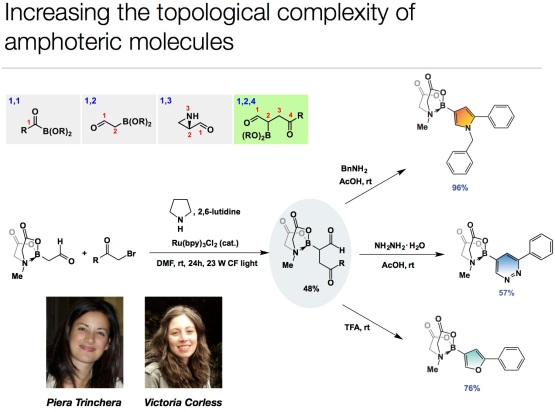My lab has been interested in new ways to access uncommon substitution motifs in aromatic heterocycles. Here is our rationale: while there are countless examples of imaginative approaches to borylate an existing ring using directed ortho-metallation or C-H activation, the corresponding reactions are governed by the innate reactivity of a given heterocycle. The selectivity also depends on the reagent that effects the site-selective transformation.
We have been thinking about ways to assemble structures using different rules. As part of this undertaking, we placed our bets on amphoteric molecules and explored ways of controlling the selectivity of boron group transfer using simple condensation reactions.
In grey rectangles below you see some of the amphoteric species described by our lab in the past. In green you see a new and surprisingly stable class of compounds described by my postdoctoral fellow Piera Trinchera and graduate student Victoria Corless in a recent Angewandte paper. The dicarbonyl scaffold, prepared using photocatalysis and organocatalysis (special thanks to MacMillan, Stephenson, and Yoon for trailblazing this area) can be transformed into several types of heterocycles with unusual regiochemistry of the C-B bond. I think medicinal chemists might be interested in this technique as there are many molecules one can imagine making using dicarbonyls. I applaud Piera and Victoria’s efforts. I was also glad to see Chemical and Engineering News comment on their research. The next issue of Angewandte will have the cover designed by Piera and Victoria, which is a nice touch (although I am left with a bill for 2100 Euros for their beautiful artwork…).
http://onlinelibrary.wiley.com/doi/10.1002/anie.201504271/abstract
http://cen.acs.org/articles/93/web/2015/06/New-Route-Rare-Heterocycles.html
I would end by pondering over a curious finding that most isomers accessible through our condensative approach are not easily accessible by alternative metal-based techniques. You might ask “Is there a reason for that?”. I would say – there ain’t one, although it is tempting to speculate on the innate selectivity of condensation reactions.


This is pretty, and useful. Congratulations to your group!
This reminds me, chlorinated quinones react with acetaldehyde and secondary amines in DMF by (likely single electron) process that results in net “Michael addition” + HCl elimination, producing Quinone-CH=CHNR2. This is the basis of chloranil test for secondary amines in peptide chemistry (these conjugated enamines are gorgeously blue). I have not seen this used synthetically, but if this enanine reaction worked with MIDA borylated acetaldehyde, one could possibly access quite a few ring-fused heterocyclic boronates from the quinone adducts.
Thanks a lot. This is an interesting point. I love that chloranil process. There is a couple of other things in this regard – I wish I could tell you more now. There are some unpublished results that I will mention in due course!
Nice work indeed, boron is never boring!
Thanks! Indeed, it is not boring. And with the growing interest in boron containing bioactive end points, another phrase from the past wisdom of medicinal chemistry (“only moron bets on boron”) also seems outdated…